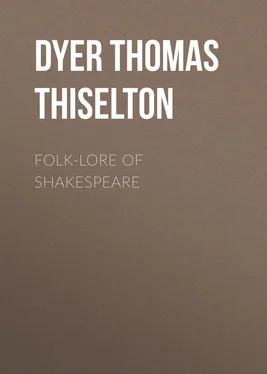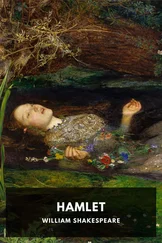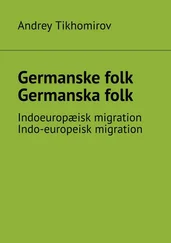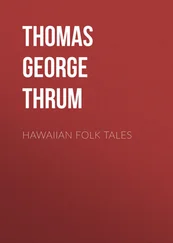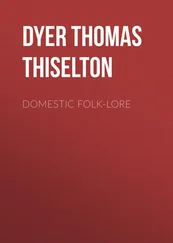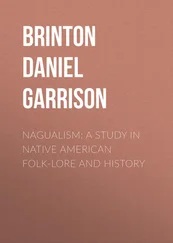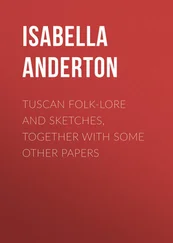Thomas Dyer - Folk-lore of Shakespeare
Здесь есть возможность читать онлайн «Thomas Dyer - Folk-lore of Shakespeare» — ознакомительный отрывок электронной книги совершенно бесплатно, а после прочтения отрывка купить полную версию. В некоторых случаях можно слушать аудио, скачать через торрент в формате fb2 и присутствует краткое содержание. Жанр: foreign_antique, foreign_prose, на английском языке. Описание произведения, (предисловие) а так же отзывы посетителей доступны на портале библиотеки ЛибКат.
- Название:Folk-lore of Shakespeare
- Автор:
- Жанр:
- Год:неизвестен
- ISBN:нет данных
- Рейтинг книги:4 / 5. Голосов: 1
-
Избранное:Добавить в избранное
- Отзывы:
-
Ваша оценка:
- 80
- 1
- 2
- 3
- 4
- 5
Folk-lore of Shakespeare: краткое содержание, описание и аннотация
Предлагаем к чтению аннотацию, описание, краткое содержание или предисловие (зависит от того, что написал сам автор книги «Folk-lore of Shakespeare»). Если вы не нашли необходимую информацию о книге — напишите в комментариях, мы постараемся отыскать её.
Folk-lore of Shakespeare — читать онлайн ознакомительный отрывок
Ниже представлен текст книги, разбитый по страницам. Система сохранения места последней прочитанной страницы, позволяет с удобством читать онлайн бесплатно книгу «Folk-lore of Shakespeare», без необходимости каждый раз заново искать на чём Вы остановились. Поставьте закладку, и сможете в любой момент перейти на страницу, на которой закончили чтение.
Интервал:
Закладка:
“Cuckoo, cherry-tree,
Good bird, tell me,
How many years have I to live” —
the allusion to the cherry-tree having probably originated in the popular fancy that before the cuckoo ceases its song it must eat three good meals of cherries. Pliny mentions the belief that when the cuckoo came to maturity it devoured the bird which had reared it, a superstition several times alluded to by Shakespeare. Thus, in “King Lear” (i. 4), the Fool remarks:
“The hedge-sparrow fed the cuckoo so long,
That it had its head bit off by its young.”
Again, in “1 Henry IV.” (v. 1), Worcester says:
“And being fed by us you used us so
As that ungentle gull, the cuckoo’s bird,
Useth the sparrow; did oppress our nest;
Grew by our feeding to so great a bulk
That even our love durst not come near your sight
For fear of swallowing.”
Once more, the opinion that the cuckoo made no nest of its own, but laid its eggs in that of another bird, is mentioned in “Antony and Cleopatra” (ii. 6):
“Thou dost o’er-count me of my father’s house;
But, since the cuckoo builds not for himself,
Remain in’t as thou may’st.”
It has been remarked, 194 194 See Mary Howitt’s “Pictorial Calendar of the Seasons,” p. 155; Knight’s “Pictorial Shakespeare,” vol. i. pp. 225, 226.
however, in reference to the common idea that the young cuckoo ill-treats its foster-mother, that if we watch the movements of the two birds, when the younger is being fed, we cannot much wonder at this piece of folk-lore. When the cuckoo opens its great mouth, the diminutive nurse places her own head so far within its precincts that it has the exact appearance of a voluntary surrender to decapitation.
The notion 195 195 Chambers’s “Book of Days,” vol. i. p. 531.
“which couples the name of the cuckoo with the character of the man whose wife is unfaithful to him appears to have been derived from the Romans, and is first found in the Middle Ages in France, and in the countries of which the modern language is derived from the Latin. But the ancients more correctly gave the name of the bird, not to the husband of the faithless wife, but to her paramour, who might justly be supposed to be acting the part of the cuckoo. They applied the name of the bird in whose nest the cuckoo’s eggs were usually deposited – ‘carruca’ – to the husband. It is not quite clear how, in the passage from classic to mediæval, the application of the term was transferred to the husband.” In further allusion to this bird, we may quote the following from “All’s Well That Ends Well” (i. 3):
“For I the ballad will repeat,
Which men full true shall find,
Your marriage comes by destiny,
Your cuckoo sings by kind.”
The cuckoo has generally been regarded as the harbinger of spring, and, according to a Gloucester rhyme:
“The cuckoo comes in April,
Sings a song in May;
Then in June another tune,
And then she flies away.”
Thus, in “1 Henry IV.” (iii. 2), the king, alluding to his predecessor, says:
“So, when he had occasion to be seen,
He was but as the cuckoo is in June,
Heard, not regarded.”
In “Love’s Labour’s Lost” (v. 2) spring is maintained by the cuckoo, in those charming sonnets descriptive of the beauties of the country at this season.
The word cuckoo has, from the earliest times, been used as a term of reproach; 196 196 See Brand’s “Pop. Antiq.,” 1849, vol. ii. p. 201.
and Plautus 197 197 “Asinaria,” v. 1.
has introduced it on more than one occasion. In this sense we find it quoted by Shakespeare in “1 Henry IV.” (ii. 4): “O’ horseback, ye cuckoo.” The term cuckold , too, which so frequently occurs throughout Shakespeare’s plays, is generally derived from cuculus, 198 198 Nares, in his “Glossary” (vol. i. p. 212), says: “Cuckold, perhaps, quasi cuckoo’d, i. e. , one served; i. e. , forced to bring up a brood that is not his own.”
from the practice already alluded to of depositing its eggs in other birds’ nests.
Domestic Fowl. In “The Tempest” (v. 1), the word chick is used as a term of endearment: “My Ariel; chick,” etc.; and in “Macbeth” (iv. 3) Macduff speaks of his children as “all my pretty chickens.” In “Coriolanus” (v. 3), hen is applied to a woman: “poor hen, fond of no second brood;” and in “Taming of the Shrew” (ii. 1), Petruchio says: “so Kate will be my hen;” and, once more, “1 Henry IV.” (iii. 3), Falstaff says, “How now, Dame Partlet the hen?” In “Othello” (i. 3) Iago applies the term “guinea-hen” to Desdemona, a cant phrase in Shakespeare’s day for a fast woman.
Dove. Among the many beautiful allusions to this bird we may mention one in “Hamlet” (v. 1), where Shakespeare speaks of the dove only laying two eggs: 199 199 Singer’s “Shakespeare,” 1875, vol. ix. p. 294.
“as patient as the female dove
When that her golden couplets are disclosed.”
The young nestlings, when first disclosed, are only covered with a yellow down, and the mother rarely leaves the nest, in consequence of the tenderness of her young; hence the dove has been made an emblem of patience. In “2 Henry IV.” (iv. 1), it is spoken of as the symbol of peace:
“The dove and very blessed spirit of peace.”
Its love, too, is several times referred to, as in “Romeo and Juliet” (ii. 1), “Pronounce but – love and dove;” and in “1 Henry VI.” (ii. 2), Burgundy says:
“Like to a pair of loving turtle-doves,
That could not live asunder, day or night.”
This bird has also been regarded as the emblem of fidelity, as in the following graphic passage in “Troilus and Cressida” (iii. 2):
“As true as steel, as plantage to the moon,
As sun to day, as turtle to her mate,
As iron to adamant, as earth to the centre;”
and in “Winter’s Tale” (iv. 4) we read:
“turtles pair,
That never mean to part.”
Its modesty is alluded to in the “Taming of the Shrew” (ii. 1): “modest as the dove;” and its innocence in “2 Henry VI.” (iii. 1) is mentioned, where King Henry says:
“Our kinsman Gloster is as innocent
From meaning treason to our royal person
As is the sucking lamb or harmless dove:
The duke is virtuous, mild and too well given
To dream on evil, or to work my downfall.”
The custom of giving a pair of doves or pigeons as a present or peace-offering is alluded to in “Titus Andronicus” (iv. 4), where the clown says, “God and Saint Stephen give you good den: I have brought you a letter and a couple of pigeons here;” and when Gobbo tried to find favor with Bassanio, in “Merchant of Venice” (ii. 2), he began by saying, “I have here a dish of doves, that I would bestow upon your worship.” Shakespeare alludes in several places to the “doves of Venus,” as in “Venus and Adonis:”
“Thus weary of the world, away she [Venus] hies,
And yokes her silver doves; by whose swift aid
Their mistress, mounted, through the empty skies
In her light chariot quickly is conveyed;
Holding their course to Paphos, where their queen
Means to immure herself and not be seen;”
and in “A Midsummer-Night’s Dream” (i. 1), where Hermia speaks of “the simplicity of Venus’ doves.” This will also explain, says Mr. Harting, 200 200 “Ornithology of Shakespeare,” pp. 190, 191.
the reference to “the dove of Paphos,” in “Pericles” (iv. Introd.). The towns of Old and New Paphos are situated on the southwest extremity of the coast of Cyprus. Old Paphos is the one generally referred to by the poets, being the peculiar seat of the worship of Venus, who was fabled to have been wafted thither after her birth amid the waves. The “dove of Paphos” may therefore be considered as synonymous with the “dove of Venus.”
Интервал:
Закладка:
Похожие книги на «Folk-lore of Shakespeare»
Представляем Вашему вниманию похожие книги на «Folk-lore of Shakespeare» списком для выбора. Мы отобрали схожую по названию и смыслу литературу в надежде предоставить читателям больше вариантов отыскать новые, интересные, ещё непрочитанные произведения.
Обсуждение, отзывы о книге «Folk-lore of Shakespeare» и просто собственные мнения читателей. Оставьте ваши комментарии, напишите, что Вы думаете о произведении, его смысле или главных героях. Укажите что конкретно понравилось, а что нет, и почему Вы так считаете.
